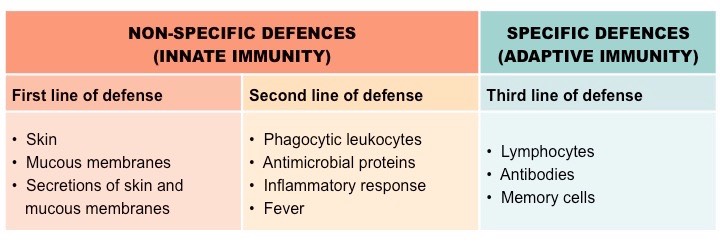The immune system can be divided into three basic lines of defense against pathogenic infection:
- The first line of defense against infection are the surface barriers that prevent the entry of pathogens into the body
- The second line of defense are the non-specific phagocytes and other internal mechanisms that comprise innate immunity
- The third line of defense are the specific lymphocytes that produce antibodies as part of the adaptive immune response
The Immune System: Three Lines of Defense

First Line of Defense
- The primary defence against infectious disease are the surface barriers that prevent pathogens from entering the body
- These surface barriers include intact skin (protect external boundaries) and mucous membranes (protect internal boundaries)
- Both the skin and mucous membranes release chemical secretions which restrict the growth of microbes on their surfaces
- If pathogens cannot enter the host body, they cannot disrupt normal physiological functions and cause disease
Second Line of Defense
- The second line of defence against infection are the non-specific cellular and molecular responses of the innate immune system
- These defences do not differentiate between different types of pathogen and respond the same way upon every infection
- Phagocytic leukocytes migrate to infection sites and engulf foreign bodies (dendritic cells then present antigens to lymphocytes)
- Inflammatory responses increase capillary permeability at infected sites, recruiting leukocytes but leading to localised swelling
- Antimicrobial proteins (such as cytokines and complement proteins) regulate immune activity within the body
- Fever increases body temperatures to activate heat-shock proteins and suppress microbial growth and propagation
Third Line of Defense
- The final line of defence against infection are the lymphocytes that produce antibodies to specific antigenic fragments
- Each B cell produces a specific antibody, and the body has millions of different B cells capable of detecting distinct antigens
- Helper T cells regulate B cell activation, ensuring that antibodies are only mass-produced at the appropriate times
- Both B and T cells will differentiate to form memory cells after activation, conferring long-term immunity to a particular pathogen
